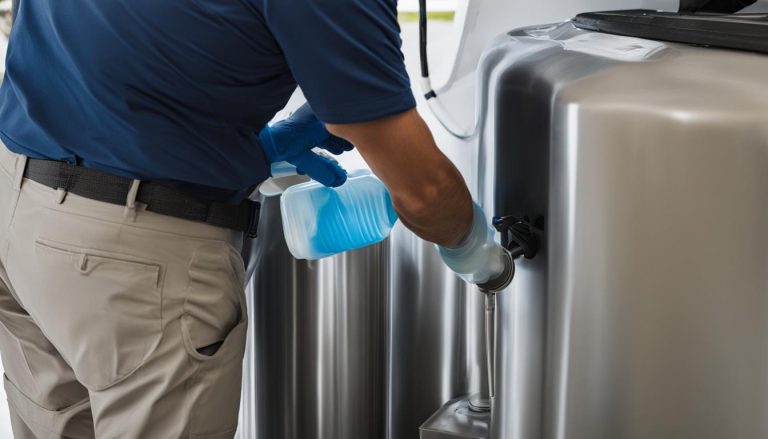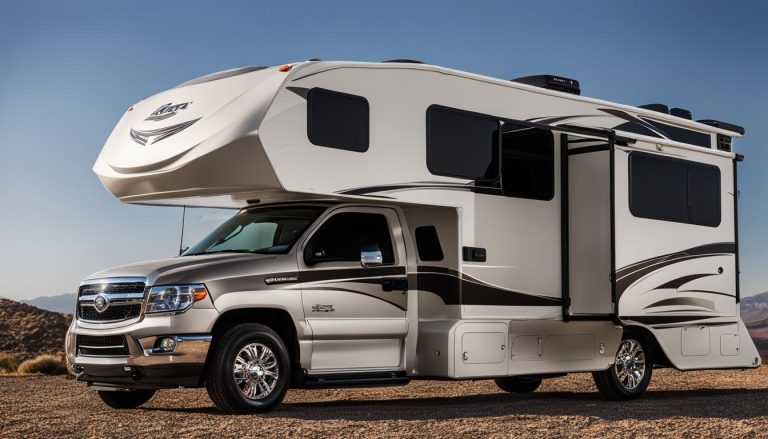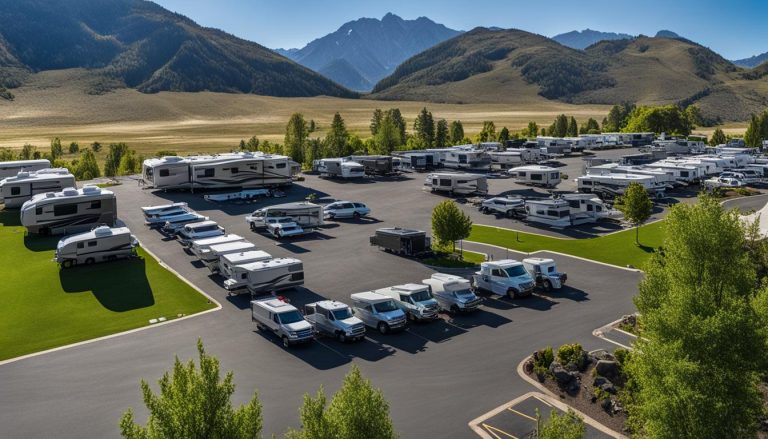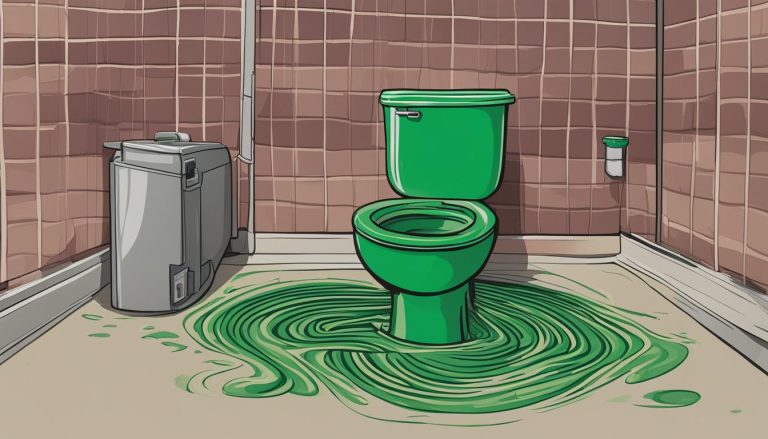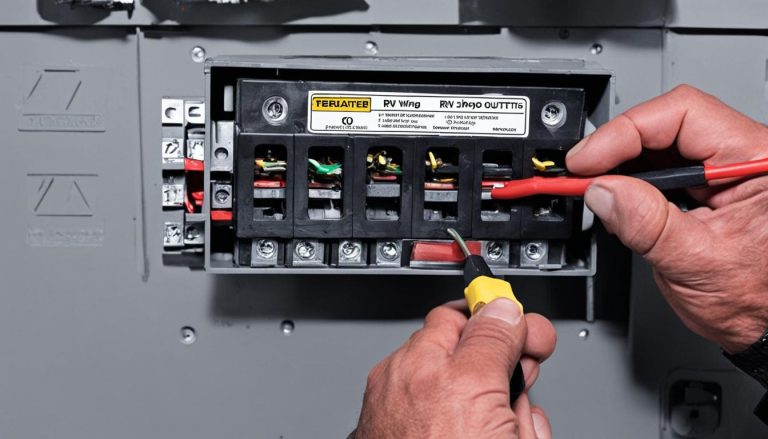Freshen Your RV: How to Clean RV Water Tank
gorvlifestyle.com and its partners may earn a commission if you purchase a product through one of our links
Welcome to our guide on how to clean your RV water tank! Keeping your RV’s water system clean and fresh is crucial for your health and enjoyment on the road. Regular cleaning and maintenance of your RV water tank will ensure that your water is safe, clean, and free from any unwanted odors or tastes. In this article, we will walk you through the step-by-step process of cleaning and sanitizing your RV water tank, so you can enjoy fresh and clean water during your travels.
- Regularly cleaning and sanitizing your RV water tank is essential to ensure clean and safe water.
- Sanitizing your RV water tank helps eliminate bacteria, mold, and mildew that may build up over time.
- It is recommended to clean your RV water tank every six months or when you notice any odd taste or smell in your water.
- To clean your RV water tank, you’ll need regular bleach, a funnel, and a clean water source.
- Follow our step-by-step guide to effectively sanitize your RV water tank and enjoy fresh water throughout your travels.
Why Sanitize Your RV Fresh Water Tank?
Sanitizing your RV fresh water tank is essential to ensure that your water is clean, safe, and free from harmful bacteria, mold, and mildew. The water used to fill your tank may not always be clean, and over time, contaminants can accumulate in the tank and water lines. By regularly sanitizing your fresh water tank, you can eliminate these potential health hazards and provide your family with access to clean and safe water throughout your RV travels.
There are several important reasons why sanitizing your RV water tank is of utmost importance:
- Preventing health risks: By eliminating bacteria, mold, and mildew from your fresh water tank, you greatly reduce the risk of waterborne illnesses and other health issues that can result from consuming contaminated water.
- Removing unpleasant odors and tastes: Without proper sanitization, your RV water tank can develop unpleasant odors and tastes that can be off-putting and make it difficult to enjoy your water. Cleaning your tank regularly helps maintain a fresh and clean water supply.
- Maintaining water system functionality: Over time, sediment and debris can accumulate in your RV water tank, potentially clogging water lines and causing damage to your RV’s plumbing system. Regular sanitization helps prevent these issues and keeps your water system functioning properly.
Sanitizing your RV fresh water tank is a simple yet crucial step in ensuring that you and your family have access to clean and safe water during your RV adventures. It’s an investment in your health and peace of mind. Remember, a clean water tank leads to a better RV travel experience!
The Benefits of Cleaning Your RV Water Tank:
| Benefit | Description |
|---|---|
| Safe and healthy water | Regular sanitization ensures the removal of bacteria, mold, and mildew, providing you with clean and safe water for drinking, cooking, and other daily activities. |
| Improved taste and smell | By eliminating contaminants and odors, cleaning your RV water tank enhances the taste and smell of your water, ensuring a more enjoyable drinking experience. |
| Prolonged water system lifespan | Proper maintenance and cleaning prevent sediment buildup and clogging, extending the longevity of your RV water system and reducing the need for costly repairs. |
| Peace of mind | Knowing that your RV water tank is clean and free from harmful contaminants gives you peace of mind, allowing you to fully enjoy your RV adventures without worrying about water quality. |
When to Sanitize RV Fresh Water Tank Systems
Sanitizing your RV fresh water tank is an important part of maintaining a clean and safe water supply for your travels. While it is generally recommended to sanitize your RV water tank every six months, there are certain signs that indicate the need for more frequent cleaning. Here are some key factors to consider:
- Odd taste or smell: If you notice any strange or unpleasant tastes or odors in your water, it’s a clear indication that it’s time to clean your RV water tank. These signs can be an indication of bacteria growth or contamination.
- RV in storage: If your RV has been in storage for an extended period, it’s important to sanitize the water tank before using it again. Stagnant water can become a breeding ground for bacteria and other microorganisms.
- Water source concerns: If you suspect that the water used to fill your RV tank was contaminated or of questionable quality, it’s crucial to sanitize the tank to ensure the safety of your water supply. This is especially important when filling up at unfamiliar locations or during camping trips in remote areas.
By regularly assessing these factors and promptly sanitizing your RV fresh water tank when necessary, you can prevent potential health issues and enjoy clean and safe water throughout your travels.
| Signs It’s Time to Sanitize RV Water Tank | Frequency of Sanitizing RV Water Tank | When to Clean RV Water Tank |
|---|---|---|
| Odd taste or smell in water | Every six months | Contaminated water source |
| RV in storage for an extended period | Suspected water contamination |
Regular maintenance and cleaning of your RV water tank will not only ensure the quality of your water but also provide peace of mind knowing that you and your family are protected from potential health risks. Now, let’s dive into the step-by-step process of cleaning your RV water tank effectively.
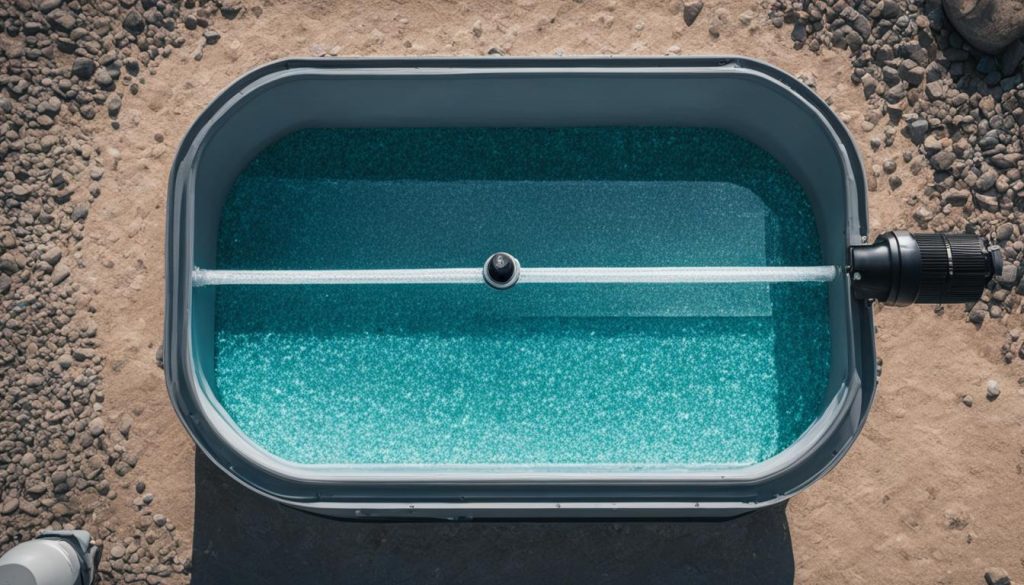
What You Need to Sanitize RV Fresh Water Tank and System
Cleaning your RV fresh water tank and system is a straightforward process that requires a few essential supplies. To effectively sanitize your tank, you will need:
- Regular bleach: This powerful cleaning agent will help eliminate bacteria, mold, and other contaminants from your RV water tank.
- A funnel: Using a funnel makes it easier to pour the bleach mixture into your RV water tank without any spills or mess.
- A clean water source: You’ll need access to clean water for rinsing out your RV water tank after the sanitization process.
These supplies are readily available and affordable, making the cleaning process accessible to all RV owners. With these basic materials in hand, you’ll be well-prepared to maintain a clean and safe water system in your RV.

How to Sanitize RV Fresh Water Tank Step-by-Step
The process of sanitizing your RV fresh water tank is relatively simple and can be done in a few easy steps. Follow the step-by-step guide below to ensure a clean and safe water supply for your RV adventures:
Step 1: Turn off Water Heater and Pump
To prevent any damage, start by turning off the water heater and pump. This step ensures that no water flows through the system while you sanitize the tank.
Step 2: Bypass Water Heater and Filter
Next, bypass the water heater and filter to avoid exposing them to the bleach mixture. This way, you can protect these components from any potential damage during the sanitization process.
Step 3: Drain the System
Drain the entire system, including the fresh water tank and lines. This will remove any existing water, ensuring a fresh start for the sanitization process.
Step 4: Prepare the Bleach Mixture
Create a bleach mixture by adding a quarter cup of regular bleach for every 15 gallons of tank capacity. Use a funnel to pour the bleach mixture directly into the fresh water tank.
Step 5: Fill the Tank with the Bleach Mixture
Fill the fresh water tank with the bleach mixture. Ensure that the solution reaches all corners of the tank to thoroughly sanitize the entire surface area.
Step 6: Turn on the Pump and Open Faucets
Turn on the water pump and open all faucets in your RV. This will allow the bleach mixture to flow through the entire water system, including the faucets and showerheads.
Step 7: Let the Solution Sit Overnight
Allow the bleach solution to sit in the tank and water lines overnight. This extended contact time will ensure that any bacteria, mold, or mildew present in the system is effectively eliminated.
Step 8: Drain the Tank and Lines
The next day, drain the bleach solution from the fresh water tank and lines. Ensure that all the solution is completely removed before proceeding.
Step 9: Refill with Fresh Water and Flush the System
Refill the fresh water tank with clean, fresh water. Open all faucets and run the water until there is no smell of bleach. This step flushes out any remaining traces of the bleach solution from the water system.
Following these step-by-step instructions will help you effectively sanitize your RV fresh water tank and ensure a clean and safe water supply for your adventures on the road.
Additional Tips for RV Water Tank Maintenance
Along with regular sanitization, there are a few additional tips you can follow to maintain your RV water tank.
Use a Water Filtration System: Install a reliable water filtration system to remove sediments and impurities from the water before it enters your RV water tank. This will help ensure that the water stored in your tank remains clean and safe for use.
Flush the Tank Regularly: Regularly flushing your RV water tank is an important maintenance practice. Flushing helps remove any stagnant water and prevents the buildup of bacteria, mold, and other contaminants. Simply drain the tank completely and refill it with fresh water.
Utilize Water Purification Tablets: Consider using water purification tablets in your RV water tank. These tablets help kill any remaining bacteria and pathogens, ensuring that your water remains safe for drinking and other uses.
Inspect the Tank: Regularly inspect your RV water tank for any leaks or signs of damage. Check for cracks, loose fittings, or any other issues that may compromise the integrity of your tank. Promptly repair or replace any damaged parts as needed.
By following these additional maintenance tips, you can prolong the life of your RV water tank and ensure the quality of your water supply.
Note: The image above illustrates the best practices for cleaning an RV water tank.
Video Guide: How to Sanitize RV Fresh Water Tank
If you prefer visual instructions, there are plenty of video guides available online that demonstrate the process of sanitizing an RV fresh water tank. Watching a video tutorial can provide a clear and detailed visual guide, making it easier to understand and follow the steps for cleaning your RV water tank.
The visual guide will take you through each step of the sanitization process, allowing you to see exactly what needs to be done. You’ll be able to follow along and ensure that you’re completing each step correctly. With a step-by-step video for RV water tank cleaning, you’ll have the confidence and knowledge to effectively sanitize your RV water tank.
These video tutorials provide valuable insights, tips, and tricks from experienced RV owners and professionals. You’ll learn about the necessary supplies, safety precautions, and best practices for maintaining a clean and safe water system in your RV. Whether you’re a beginner or a seasoned RV owner, these videos can help you enhance your cleaning routine and ensure the longevity of your RV water tank.
Enjoy Fresh and Clean Water in Your RV
By regularly cleaning and sanitizing your RV water tank, you can ensure that your family has access to fresh, clean, and safe water during your RV adventures. Maintaining a clean water system is essential for the overall well-being of everyone onboard. With clean water, you can enjoy cooking, drinking, showering, and other daily activities without worrying about contaminants or unpleasant tastes.
Regular maintenance, including sanitizing your RV water tank, will help keep your water system in optimal condition. This not only ensures the quality of your water but also extends the lifespan of your RV’s plumbing components. By following the recommended maintenance tips and best practices, you can prevent the growth of bacteria, mold, and mildew, which can cause health issues and unpleasant odors.
Imagine embarking on your next RV adventure with the peace of mind that comes from knowing your water is free from harmful bacteria and contaminants. By prioritizing the cleanliness of your RV’s water system, you can enjoy your travels to the fullest, savoring the taste of fresh water and creating lasting memories with your loved ones.
FAQ
How often should I clean my RV water tank?
It is generally recommended to sanitize your RV fresh water tank every six months. However, if you notice any odd taste or smell in your water, if your RV has been in storage for a while, or if you suspect that the water used to fill your tank was contaminated, it is essential to clean your RV water tank.
What supplies do I need to clean my RV water tank?
To effectively sanitize your tank, you will need regular bleach, a funnel, and a clean water source. These supplies are readily available and affordable, making the cleaning process accessible to all RV owners.
How do I sanitize my RV water tank step-by-step?
The process of sanitizing your RV fresh water tank is relatively simple and can be done in a few easy steps. First, you need to turn off the water heater and pump to prevent any damage. Then, you bypass the water heater and filter, drain the system, and create a bleach mixture to add to the tank. After filling the tank with the mixture, you turn on the pump and open the faucets to let the solution run through the system. After letting it sit overnight, you drain the tank and lines, refill with fresh water, and flush the system until there is no smell of bleach.
Why is sanitizing my RV fresh water tank important?
Sanitizing your RV fresh water tank is crucial because the water used to fill your tank may not always be clean. Over time, bacteria, mold, and mildew can grow in the tank and water lines. By sanitizing your fresh water tank, you can eliminate any potential contaminants and ensure that your family has access to clean and safe water during your RV travels.
Are there any additional tips for maintaining my RV water tank?
Along with regular sanitization, there are a few additional tips you can follow to maintain your RV water tank. It is important to use a water filtration system to remove any sediments or impurities from the water before it enters the tank. Additionally, flushing the tank regularly and using water purification tablets can help keep the water clean and fresh. Regular inspection of the tank for any leaks or damage is also recommended.
Is there a video guide available for sanitizing an RV fresh water tank?
Yes, there are plenty of video guides available online that demonstrate the process of sanitizing an RV fresh water tank. Watching a video tutorial can provide a clear and detailed visual guide, making it easier to understand and follow the steps for cleaning your RV water tank.
How can I enjoy fresh and clean water in my RV?
By regularly cleaning and sanitizing your RV water tank, you can ensure that your family has access to fresh, clean, and safe water during your RV adventures. Following the recommended maintenance tips and best practices will help keep your water system in optimal condition and provide peace of mind knowing that your water is free from bacteria and contaminants.

